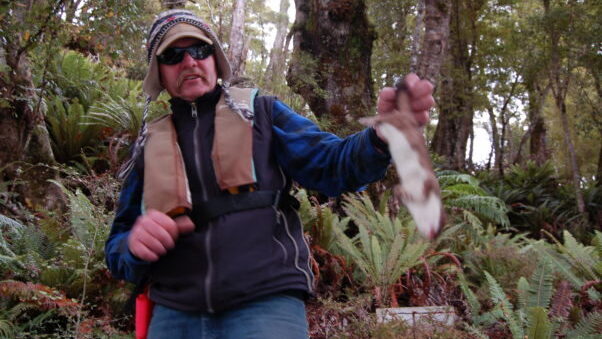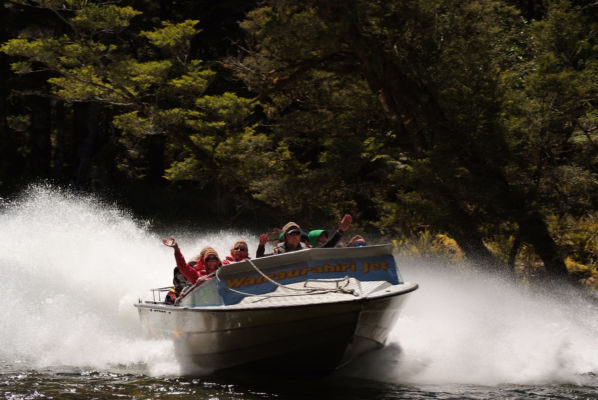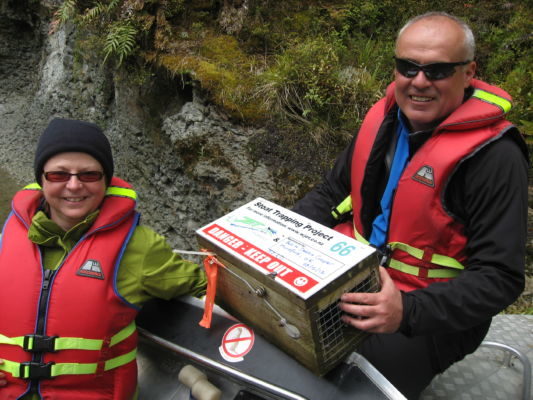Once upon a time, Johan Groters and Joyce Kolk were Southland farmers. Then in 1994, Johan and some friends formed a partnership, got a jetboat concession and began to share their love of the remote Fiordland wilderness on their doorstep by taking visitors up the Wairaurahiri River.

At first the jetboat venture was just a fun hobby. Johan still relied on farming for his main income for the next 6 years. Then in 2000, when the partnership split, Johan got a new boat and began taking people up the remote Wairaurahiri River fulltime. It’s still fun – but Wairaurahiri Jet is now an award-winning ecotourism venture, sharing the beauty of Fiordland’s remote Wairaurahiri River, Lake Hauroko and surrounding bush with visitors from New Zealand and around the world.
“In 2006 we started trapping,” Joyce says. “We had noticed there were no birds, so we went to DOC initially to see if they could supply traps. They thought it was a good idea, but because it wasn’t an eradication, they couldn’t help fund it. So we went for trap sponsorship.”
Individual trap sponsors pay $275 to sponsor a stoat trap for two years – and that sponsorship includes a free jetboat ride worth $249. Sponsors can then follow their trap’s stoat tally which is updated regularly on the company’s website.

“Early supporters were tour companies, New Zealand In Depth and ID Tours NZ, whose clients were mainly inbound British tourists,” says Joyce, “One of the initial tourists renewed their sponsorship after the 2-year period, even though they weren’t revisiting New Zealand.”
That was when Joyce knew the trapping programme was striking a chord with visitors.
Local companies have also been key corporate sponsors. A corporate sponsorship involves sponsoring 10 stoat traps. In return, the company receives a jetboat trip for 10 people and free accommodation overnight at remote Waitutu Lodge, set in the pristine Waitutu Forest ten minutes walk from the South Coast and two days walk from the nearest road – a great idea for a team-building getaway.
Ten traps weren’t enough for a group of Queenstown builders. They decided to sponsor 18.
“There are 120 traps on the South Coast track,” says Joyce, with another 39 on one side of Hump Ridge and 49 on the other side. There are – or were – up to 80 on the riverbank, but a recent high river flow may have washed some of those away.”
Jetboat passengers learn about the threats to New Zealand’s native birdlife from introduced mammals such as stoats and rats and also get to look out to see if any traps have been triggered.
“There’s a flag system on the river traps, so that a flag goes up. Tourists look out for the flags as we go up the river.”
The river traps are checked once a year and rebaited. Otherwise they are checked when they have caught something and rebaited. The traps on the Hump and South Coast tracks are checked and rebaited Monthly
“We used salted venison which doesn’t go off, “It doesn’t last forever it goes slimy and is replaced says Joyce. “Jetboat tours include a complementary venison lunch and any leftover offcuts are salted.”
Other baits have also been tried by various trappers in the area.

“A friend uses peanut butter spray,” says Joyce, “and some volunteers use eggs. We’ve tried dried fish and one of the Hump Track guides is using salted possums!”
Visitors walking the Hump Track are given a bird book where they can mark which birds they see. Joyce logs the results from the logbooks and also walks the track once a month herself.
“People are commenting on the increase in birdlife around the Teal Bay hut at Lake Hauroko,” says Joyce. “We got 50 stoats in one area in just six months. There was a big increase in rats in November and now we’re getting a huge amount of stoats – 19 stoats in 70 traps. A total of 41 traps caught 24 rats back in November.”
The opportunity to support the trapping programme is popular with tourists.
“One lady has been a supporter for 8 years,” says Joyce. “She buys 3 traps every year as Christmas presents for her friends. She comes over from the US and last year she helped put out her 3 traps. This year she did the guided walk on the Hump Ridge track and could help check the traps.”
Track guides regularly check the Hump Ridge tracks. Again, Joyce and Johan have a system for saving time and making trap checking easy – one that might also prove useful for other community trappers.
“There’s a cable tie on the handle of the DOC 200 traps,” Joyce explains. “It sits outside the trap box then if the trap is triggered it goes inside. It means the guides don’t have to stop at every trap.”
The Wairaurahiri Jet ecotourism venture has won several local environmental awards. It’s a great example of how business and conservation can work well together. Wairaurahiri is also the only jetboat company to win an environmental gold award from Qualmark – the New Zealand tourism industry’s official quality assurance organisation.
“The awards aren’t the reason we do it,” says Joyce, “but it’s good to have that recognition.”
In the future, Joyce and Johan would like to share trap and bird data with DOC. They’d also like to make the Hump Ridge track predator-free.
“One end is open,” says Joyce, but the rest has natural boundaries – the ocean, lake and river. It would need to have 1080, but the other side has been done 3 times. There’s a 10 mile stretch. A ‘pie in the sky’ ambition would be to have a predator fence.”

